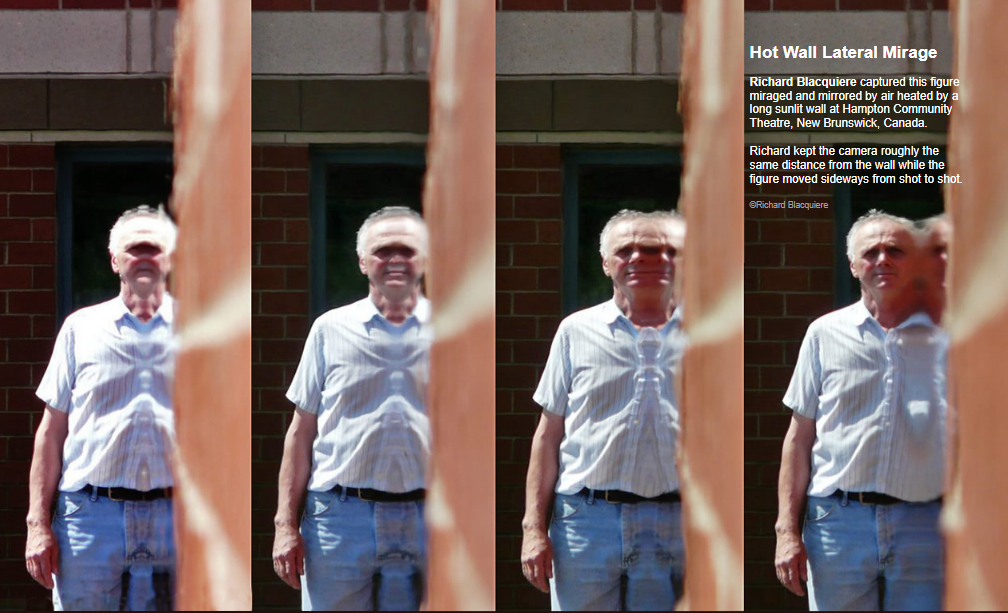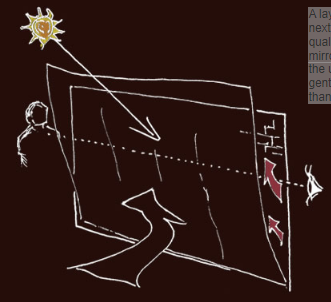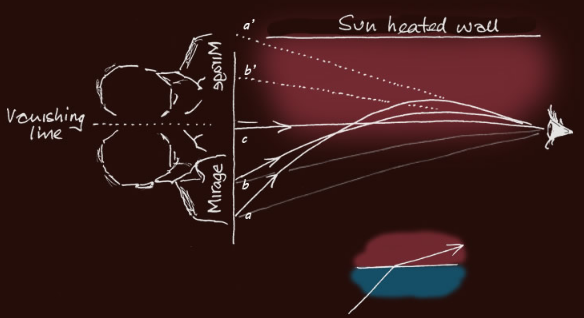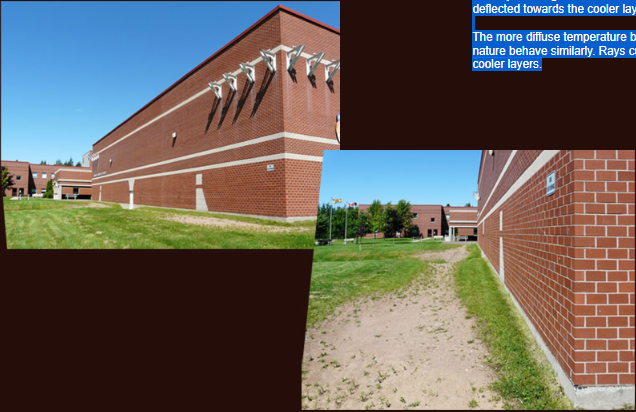Hot wall lateral mirage - OPOD
Hot Wall Lateral Mirage - A Mesmerizing Optical Phenomenon
Have you ever witnessed a mirage that seems to distort reality? The hot wall lateral mirage is a captivating atmospheric optics phenomenon that can leave you in awe. It occurs when a layer of warm air forms next to a sunlit wall, creating a mirror-like effect that reflects and distorts images. In this article, we will delve into the intricacies of this mesmerizing phenomenon and explore its underlying mechanisms.
Unveiling the Mirrored Illusion
The symmetrical nature of the human face and figure can make it challenging to distinguish between the real person and the mirrored image near the wall. The mirage even extends to the point of overlapping and eroding the wall, particularly at its top. This illusion is made possible by the formation of a layer of warm air next to the sunlit surface, which acts as a medium for the mirage to manifest.
The Vanishing Line and Symmetry
Within the hot wall lateral mirage, there exists a vanishing line that marks the position where the 'real' image is cut off by the mirage. Rays of light from points 'a' and 'b' can reach the observer's eye through different paths. While rays closer to the wall than point 'c' do not reach the eye at all, point 'c' itself becomes significant as it denotes the vanishing line. This vanishing line serves as a pivotal point of symmetry within the mirage.
Lateral Mirages and Vertical Air Layers
Lateral mirages, such as the hot wall lateral mirage, differ from their horizontal counterparts, such as mirages created by hot roads that resemble reflections in water. In lateral mirages, air layers of different temperatures are stacked vertically rather than horizontally, with the mirrored image appearing close to and overlapping the hot wall. This vertical arrangement creates a unique visual experience, challenging our perception of reality.
Tracing the Path of Mirage Rays
Visualizing the path of mirage rays can be perplexing due to their almost straight trajectory. Attempting to create a scale diagram of these rays would result in an impossibly long and narrow representation. However, an exaggerated diagram can help illustrate the curvature of the rays. Rays from point 'a' that reach the observer's eye penetrate deeply into the warm-cold air boundary, curving outwards from the wall and creating the appearance of a mirrored figure near point 'a''. On the other hand, rays from point 'b' are refracted more gently, resulting in the perception of a second mirrored figure closer to the wall.
The Role of Refraction in Mirage Formation
Refraction plays a crucial role in the formation of mirages, including the hot wall lateral mirage. As light passes through the boundary between warm and cold air layers, it is refracted across the temperature gradients. This refraction causes the rays to curve towards cooler layers, ultimately creating the illusion of a mirrored image. The gradual temperature boundaries found in nature exhibit similar behavior, with rays curving towards cooler regions.
Path Length and Mirages
Mirages require long path lengths to manifest fully. The refractive index differences between hot and cold air are minute, resulting in only slight deviations in the path of light rays. Therefore, for mirages to be prominent, a substantial distance must be covered. In the case of the hot wall lateral mirage, the length of the wall plays a crucial role in creating an extensive path length for the mirage to develop fully. Photographers aiming to capture these mesmerizing optical phenomena often require long lenses to capture the intricacies of these mirages.
The hot wall lateral mirage is a captivating display of atmospheric optics that challenges our perception of reality. Its mirrored illusion, vanishing line, and symmetrical nature make it an intriguing phenomenon to observe. Understanding the underlying mechanisms, such as the role of refraction and the importance of path length, adds to our appreciation of this mesmerizing optical display. So, keep an eye out for this remarkable mirage, and perhaps you will be fortunate enough to witness its enchanting allure.

Hot Wall Lateral Mirage
Richard Blacquiere captured this figure miraged and mirrored by air heated by a long sunlit wall at Hampton Community Theatre, New Brunswick, Canada.
Richard kept the camera roughly the same distance from the wall while the figure moved sideways from shot to shot.
©Richard Blacquiere
The symmetry of the human face and figure make it less than obvious that the image near to the wall is a completely new and mirrored version of the real person. The mirage has even started to overlap and erode the wall, particularly at its top.
A layer of warm air formed next to the sunlt wall. The quality and clarity of the mirrored figure suggest that the upward air flow was gentle and laminar rather than turbulent.

Vanishing line:
Two rays from "a" can reach the eye - an almost undeviated ray, shown lightly, and one sharply refracted across the air layers.
Point "b" is similar.
Point "c" is different. Only one ray can reach the eye. Rays closer to the wall than "c" do not reach the eye at all. "c" marks the position of the vanishing line where the 'real' image is cut off by the mirage.
The mirage has symmetry about the vanishing line.

Lateral mirages, as these are called, are similar to the mirages made by hot roads that resemble reflections in water. In lateral mirages the air layers of different temperatures are stacked vertically rather than horizontally and the mirror image is close to (and overlapping) the hot wall.
It is not easy to picture mirage rays because they are almost straight and a scale diagram would be impossibly long and narrow. At lower left is an attempt. Distances from the wall are highly exaggerated to show the ray curvatures.
A ray from "a" that can reach the eye penetrates deeply into the warm/cold air boundary. The ray is refracted across the temperature gradients to curve back outwards from the wall so that it appears to come from "a' ". Rays from "b" reaching the eye do not approach the wall so closely and they are more gently refracted. The refracted rays appear to come from a second mirrored figure close to the wall.
The 'real' figure remains visible via almost undeviated rays from "a" and "b" that do not penetrate into the hot air layers. These are drawn very lightly
Refraction across a hypothetical and unphysically sharp cool to warm air boundary. The ray entering the hotter and less dense air is deflected towards the cooler layer.
The more diffuse temperature boundaries of nature behave similarly. Rays curve towards cooler layers.

The 35m long wall and, at right, the camera location. A long lens is needed for mirages!
Mirages need long path lengths. The refractive index differences between hot and cold air are so small that ray deviations are tiny.
A cold north facing wall might just produce a superior mirage - a challenge for photographers!
Note: this article has been automatically converted from the old site and may not appear as intended. You can find the original article here.
Reference Atmospheric Optics
If you use any of the definitions, information, or data presented on Atmospheric Optics, please copy the link or reference below to properly credit us as the reference source. Thank you!
-
<a href="https://atoptics.co.uk/blog/hot-wall-lateral-mirage-opod/">Hot wall lateral mirage - OPOD</a>
-
"Hot wall lateral mirage - OPOD". Atmospheric Optics. Accessed on November 26, 2024. https://atoptics.co.uk/blog/hot-wall-lateral-mirage-opod/.
-
"Hot wall lateral mirage - OPOD". Atmospheric Optics, https://atoptics.co.uk/blog/hot-wall-lateral-mirage-opod/. Accessed 26 November, 2024
-
Hot wall lateral mirage - OPOD. Atmospheric Optics. Retrieved from https://atoptics.co.uk/blog/hot-wall-lateral-mirage-opod/.